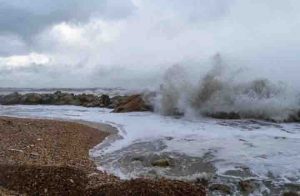
One way to understand how ocean acidity can change, for example, in response to rising carbon dioxide (CO2) levels, is to look to the history of seawater acidity. Dr. Itay Halevy of the Weizmann Institute of Science has looked to the distant past — all the way back to Earth’s earliest oceans. The model he developed, together with Dr. Aviv Bachan of Stanford University, suggests that the early oceans, right around the time that life originated, were somewhat acidic, and that they gradually became alkaline. The study, published in Science, sheds light on how past ocean acid levels were controlled by CO2 in the atmosphere, an important process for understanding the effects of climate change.
Acidity and alkalinity are measured on the pH scale of 0-14. On this scale, 7 is neutral, higher is alkaline, lower is acidic. At around 8.2, today’s oceans are mildly alkaline, and we know that rising CO2 levels are currently increasing the oceans’ acidity (decreasing pH).
Halevy, of the Weizmann Institute’s Earth and Planetary Sciences Department, explains that billions of years ago “the early Sun was dimmer, even though we don’t have evidence for a much colder climate. We think that this is because the early atmosphere had more of the greenhouse gas CO2 than at present, and that as the Sun got brighter, CO2 levels decreased,” says Halevy.
CO2, and water produce carbonic acid, so it stands to reason that the early oceans would have been more acidic. But higher early CO2 levels would also have resulted in acidic rainwater and this, in turn, could have led to higher rates of chemical weathering of Earth’s rocky crust, washing down ions that would partly neutralize the acidity of CO2. Which effect is the stronger? This has been unclear; thus previous models of the history of seawater pH have come up with everything from high values to low.
The model that Halevy and Bachan developed accounts for these processes and the way in which they influence the fluxes of ions into and out of ocean water. According to their model, the acidifying effect of higher CO2 levels dominated, and the early oceans had a lower-than-present pH.
“On a very fundamental level,” says Bachan, “we show that the pH of the ocean has been controlled by a few simple processes for all of geologic time.”
Putting numbers to the proposed pH, Halevy says that three to four billion years ago, the pH of ocean water was somewhere between 6.0 and 7.5 — between that of milk and human blood. Halevy: “This gives us some clues as to the conditions under which life emerged in the early oceans.”
“We had an early ocean more acidic than today in which primitive life thrived and chemical cycles were balanced; but if we want to apply this insight to today, we have to remember that this balance of acids and bases was maintained over geological timescales — millions of years,” he adds. “Today’s acidification from CO2 is much more rapid, so this model does not apply to the short-term problem. Hundreds of thousands of years from now, the oceans will have found a new balance, but between now and then, marine organisms and environments may suffer.”
Reference:
I. Halevy, A. Bachan. The geologic history of seawater pH. Science, April 2017 DOI: 10.1126/science.aal4151
Note: The above post is reprinted from materials provided by Weizmann Institute of Science.










